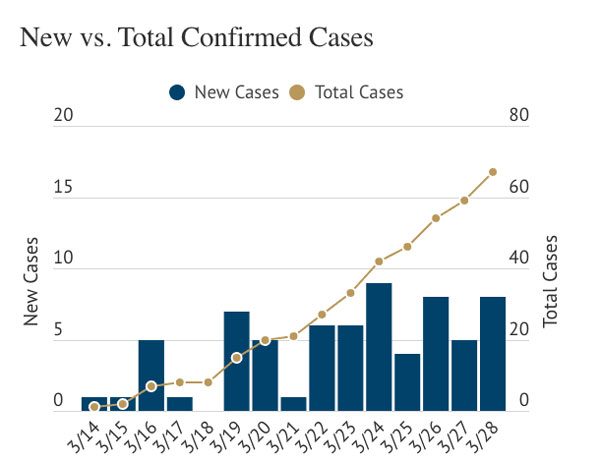COVID-19: SLO County reports 71 coronavirus cases, 24 recoveries
Click here for the latest March 30 COVID-19: update: SLO County reports 77 coronavirus cases, 27 recoveries
–On Sunday, March 29, at 1 p.m., the County of San Luis Obispo updated the community regarding the COVID-19 pandemic. At this time 71 local residents have tested positive for the COVID-19 coronavirus. That’s four more cases than reported Saturday and appears to show a stable rate of new infections. The county reports that 24 local patients have now recovered from the virus, one is in intensive care units, nine are hospitalized, and 38 are at home.
There are 36 cases in North San Luis Obispo County, 20 cases in Paso Robles, 11 cases in Atascadero, and five cases in Templeton. By Monday morning, there were at least 6,356 cases and 132 deaths in the State of California and 143,527 cases and 2,573 deaths in the United States, according to Johns Hopkins University.
Information as of 1 p.m., March 29:
Distribution of COVID-19 cases in San Luis Obispo County
- Paso Robles reported COVID-19 cases: 20
- Arroyo Grande reported COVID-19 cases: 11
- Atascadero reported COVID-19 cases: 11
- City of San Luis Obispo reported COVID-19 cases: 7
- Morro Bay reported COVID-19 cases: 6
- Templeton reported COVID-19 cases: 5
- Nipomo reported COVID-19 cases: 5
- Other San Luis Obispo County reported COVID-19 cases: 6
Ages of COVID-19 cases in San Luis Obispo County
- Age 0-17 years old – 3
- Age 18-49 years old – 29
- Age 50-64 – 18
- Age 65 years or older – 21
Cases of COVID-19 by status in San Luis Obispo County
- At home – 38
- Hospitalized – 9
- Hospitalized in intensive care – 1
- Recovered – 24
- Deaths – 0
Source of transmission of COVID-19 cases in San Luis Obispo County
- Travel related transmission – 27
- Known person-to-person transmission – 23
- Unknown community-acquired transmission –15
- Unknown – 6
Cases of COVID-19 by testing laboratory
- SLO County Public Health Lab –33
- Private labs – 37
Private labs doing testing include WestPac Labs, Quest Diagnostics, Pacific Diagnostic Laboratories, LabCorp, VRDL. As of Sunday afternoon, the county reports conducting 404 COVID-19 tests. An unknown number of residents have been tested by private labs, the county reports.
Regional COVID-19 coronavirus cases by county
San Luis Obispo County’s total number of COVID-19 cases is higher than its neighboring counties and much higher as a percentage of population. SLO County has more confirmed cases than any other county between San Jose and Ventura County. Information posted as of 7 a.m., March 30, subject to updates:
- Monterey County cases – 32 confirmed, 1 death, 452 tested
- San Benito County cases – 14 confirmed, 2 recovered, 1 death, 170 tested
- Fresno County cases – 43 confirmed, 325 tested
- Kings County cases – 2 confirmed, 88 tested
- Kern County cases – 50 confirmed, 1 death, 1,950 tested
- Santa Barbara County cases – 68 confirmed, at least 11 recovered, 706 tested
- Ventura County cases – 98 confirmed, 23 hospitalized, 3 deaths,1,574 tested
- Los Angeles County cases – 2,136, 37 deaths, at least 11,000 tested
Recent updates include
- Schools will remain closed and that distance learning for students will start on Monday.
- Closures to piers, beach parking lots, campgrounds, and parks.
- Plans to create a field hospital by April 8 at Cal Poly with 400-700 beds
- Call for volunteers to dramatically increase the county’s Medical Reserve Corps
- Operations limited at SLO County Courts
Additional information from the State of California, County of San Luis Obispo, and other agencies:
Monday at noon: Governor to announce major Initiative to surge health care workforce
SACRAMENTO – On Monday, Governor Gavin Newsom will join California health care workers on the front lines of the fight against COVID-19 and announce a major initiative to surge California‘s health care workforce. He will also provide an update on California’s response to the pandemic.
Beginning this week, the Governor will hold his daily briefings for Californians at 12:00 p.m. PDT. The updates will be streamed at the @CAgovernor Twitter page and California Governor Facebook page.
COVID-19 in California by the numbers
The following numbers reflect information received by local health jurisdictions as of 2 p.m., March 27.
- 4,643 – Positive cases
- 101 – Deaths (including one non-California resident)
- 923 – Community-acquired cases
- 3,720 – Cases acquired through person-to-person transmission, travel (including cruise ship passengers), repatriation, or under investigation. This includes 73 health care workers.
Ages of all confirmed positive cases in California
- Age 0-17: 54 cases
- Age 18-49: 2,368 cases
- Age 50-64: 1,184 cases
- Age 65+: 1,016 cases
- Unknown: 21 cases
Gender of all confirmed positive cases in California
- Female: 2,057 cases
- Male: 2,536 cases
- Unknown: 50 cases
California’s leading digital platforms, businesses, and celebrities, partner with the State to amplify ‘Stay Home – Save Lives,’ message
SACRAMENTO — California Governor Gavin Newsom on Sunday announced that leading social media companies, businesses, leaders, and individuals from across the state have leapt into action to partner and support the COVID-19 public awareness campaign. The partnerships include sharing content with the public through social media and other digital platforms, radio and television, and outdoor advertising.
“This is a crisis that is affecting all of us, and it is critical that every Californian does their part to meet this moment by staying home and exercising social distancing. I am very proud to see these Californians step up and reach out to everyone they can with that message,” said Governor Newsom. “It is no surprise that some of the world’s leading media and digital companies, many of which have headquarters located in our great state, are among the first to step up and join the fight against COVID-19.”
Companies like Google, Facebook, Instagram, Twitter, TikTok, and Spotify are making advertising space available to help ensure Californians get critical COVID-19 messages. Additionally, philanthropic organizations such as the Chan Zuckerberg Initiative are offering support and resources.
The state has launched a public awareness campaign to keep Californians informed, including creating nearly a dozen Public Service Announcements (PSAs) featuring First Partner Jennifer Siebel Newsom, California Surgeon General Dr. Nadine Burke Harris, and California Department of Public Health Director Dr. Sonia Angell. The campaign also includes accessible and shareable social media graphics, videos, and key messages such as tips for stopping the spread of COVID-19, reminding Californians of which essential resources and services remain open, and providing guidance on how to stay healthy.
Currently, more than 1,000 of California’s radio and television broadcasters have received the campaign’s PSAs and messages to share on their airwaves— so that all Californians will see the message to “Stay home. Save lives” — thanks to local ABC, CBS, NBC, FOX and Telemundo broadcast networks, Comcast Ad Distribution, the California Broadcasters Association, Entercom, Enterprise, and Ethnic Media Services. In addition, more than 450 digital billboards and outdoor advertisements are visible statewide in both English and Spanish thanks to ClearChannel, OutFront Media, Veale Outdoor Advertising, General Outdoor, VisCom Outdoor, iKahan Media and M Entertainment.
As of today, California businesses have invested more than $6.5 million in services and resources to help get the word out to Californians, and it will grow exponentially as additional partnerships develop and solidify. This is a vital investment not just in the campaign itself, but in the health and well-being of the people of California. GMMB, Inc., an advertising firm, is providing strategic communications support and managing the various media partnerships.
Listen to @SnoopDogg. #StayHomeSaveLives pic.twitter.com/VdruzU8fb6
— Gavin Newsom (@GavinNewsom) March 24, 2020
332 new cases of COVID-19 in LA County on Sunday – 21-percent hospitalization rate reported
LOS ANGELES – On Sunday, the Los Angeles County Department of Public Health (Public Health) has confirmed five new deaths and 332 new cases of 2019 Novel Coronavirus (COVID-19). Five of the six deaths reported yesterday occurred in people over the age of 60, and one death was reported for an individual between 50 – 60 years old. Two of these individuals, including the person between 50-60 years old, did not have any reported underlying health conditions. Additional information regarding some of the new cases is pending further investigation. Over the last 48 hours, there have been 676 new cases.
To date, Public Health has identified 2136 cases across all areas of LA County, including 37 deaths. Upon further investigation, one case reported earlier was not an LA County resident. As of today, 453 people positive for COVID-19 (21% of positive cases) have been hospitalized.
Current Health Officer Orders prohibit any public or private gatherings or events and temporarily close all beaches and hiking trails throughout the entire County. Only essential business remain open, and individuals are asked to stay home except to obtain essential goods or services. Health Officer Orders will continue through April 19.
“Our hearts and prayers go out to all the families and friends of individuals who have died. I ask that everyone please do your part to not infect others or become infected yourself by adhering to the public health directives and practicing social distancing,” said Barbara Ferrer, PhD, MPH, MEd, Los Angeles County Public Health Director. “More than ever, it is crucial that we practice social distancing, and if we are sick, even with mild illness, make every effort to self-isolate from others for at least 7 days and 3 more days after being symptom free. Everyone should make plans for how you will manage in case you need to self-isolate or self-quarantine. Those who have been in close contact with a person who is positive for COVID-19 should self-quarantine for 14 days. If we all commit ourselves to stay home, stay away from others when sick, and stay 6 feet apart when out, we will save lives. ”
Closed: Oceano Dunes and Pismo State Beach
—Effective Saturday, the California Department of Parks and Recreation has temporarily closed vehicular access to Pismo State Beach and Oceano Dunes Vehicular Recreation Area (SVRA), including the Oso Flaco Lake parking lot. These two sites are the latest additions to a list of parks the state has closed to vehicles in an effort to discourage crowds and limit the spread of the coronavirus disease 2019 (COVID-19) locally.
“In normal times, we welcome out-of-town visitors to our campgrounds and beaches ⎯ but now is not the time,” said County Emergency Services Director Wade Horton.
The following State Parks in San Luis Obispo County are now temporarily closed to vehicular access:
- Cayucos State Beach
- Hearst Castle
- Morro Bay State Park
- Morro Strand State Beach
- Oceano Dunes State Vehicular Recreation Area (SVRA)
- Pismo State Beach
California State Parks has implemented various safety measures in recent weeks, such as temporarily closing all campgrounds, museums, and visitor centers in the parks system; cancelling all events; and closing vehicular traffic to parks experiencing high visitation. As of today, all non- campground outdoor areas of parks, including trails and beaches, remain open. Day-use restrooms also remain open, and visitors are advised to bring soap for handwashing and to use alcohol-based hand sanitizers when water is not available.
The County’s recent Shelter at Home order does not restrict residents from going outdoors for exercise or recreation as long as they are able to keep a physical distance of six feet from other people. Individuals who are members of the same household do not need to maintain this physical distance from each other.
State Parks is working closely with local County and Public Health officials and assessing park operations daily to provide access to healthy outdoor recreation while maintaining required physical distancing. If necessary, additional closures will be enacted in the coming days.
An updated list of closures is available online at www.parks.ca.gov/FlattenTheCurve
County’s transient occupancy tax deadline extended
An upcoming tax deadline has been extended for commercial lodging businesses and vacation rentals in the unincorporated areas of San Luis Obispo County during the coronavirus disease 2019 (COVID-19) pandemic. Incorporated cities may have slightly different rules for businesses within their jurisdiction.
Payment of Transient Occupancy Tax (TOT) collected in the unincorporated areas during the months of February and March 2020 may be paid by August 31, 2020 to avoid penalty or interest. These payments are normally due the month after collection. Payment deadlines return to regular due dates beginning with April TOT collections, which are due by May 30, 2020.
While TOT provides funding for vital services being delivered to the public during this emergency, the Tax Collector recognizes lodging operators have been severely impacted and hopes to ease the impacts of tax burdens by offering flexibility with payment deadlines.
ELIGIBILITY FOR DEADLINE EXTENSION
To qualify for a waiver of penalties or interest on February and March TOT payments, operators must:
- File their February and March TOT returns on standard deadlines (plus seven-day grace period). Payment of TOT is not required until August 31, 2020
- February and March filings must include payment of County Business Improvement District (CBID) and Tourism Management District (TMD) assessments. Only TOT payments may be delayed.
The Tax Collector’s public service counter is currently closed, but staff are available Monday through Friday, 8 a.m. to 5 p.m. at (805) 781-5831 to assist taxpayers interested in extending the deadline for February and March TOT payments. Questions may also be submitted online at ttc@co.slo.ca.us.
The Transient Occupancy Tax ( TOT ) is a tax imposed on transient guest for the privilege of occupancy in any hotel, inn, motel, homestay, vacation rental or other commercial lodging for sleeping purposes for a period of thirty (30) consecutive calendar days or less. More information and ongoing Tax Collector updates can be found at www.slocountytax.org.

Governor Newsom, Mayor Liccardo and Bloom Energy CEO KR Sridhar visit ventilator refurbishing site in Sunnyvale, Calif.
Governor Newsom tours Bloom Energy – a company refurbishing ventilators for the coronavirus pandemic
SUNNYVALE – Saturday, California Governor Gavin Newson and San Jose Mayor Sam Liccardo toured the Bloom Energy ventilator refurbishing site in Sunnyvale. Through a partnership with the state, Bloom Energy has transformed its production facility to quickly refurbish life-saving ventilators to provide California with the critical equipment it needs to prepare for a potential surge in COVID-19 patients.
Bloom Energy is among many businesses partnering with the state to assist Californians as COVID-19 continues to spread.
“Across our state, companies big and small are stepping up to meet this moment, and assist our efforts to respond to this crisis,” said Governor Newsom. “California has always been a leader in innovation, and to see this innovation and these incredible resources being used to ensure the people on the front lines of COVID-19 have the resources they need to save lives embodies California’s giving spirit.”
At the onset of the pandemic, California had approximately 7,500 ventilators across its hospital systems. The state set a goal of adding an additional 10,000 ventilators. To date, the state has added 4,252 ventilators, approximately 1,000 of which needed to be refurbished. Through a partnership with the state, Bloom Energy is working to refurbish ventilators in real time. Yesterday, Bloom Energy refurbished 80 ventilators and it expects to refurbish an additional 120 ventilators today.
After Los Angeles received 170 ventilators from the federal stockpile that weren’t working, California quickly got a truck yesterday to deliver them to Bloom Energy for repair. They are due to be returned to Los Angeles on Monday, fully functional.
Additionally, more than 350 businesses and manufacturers in California reached out to offer to re-tool their facilities to make medical supplies and essential products during this crisis. Some of them include The Gap and St. John Knits making masks, gowns and scrubs for hospital workers; and Anheuser-Busch and other distilleries pivoting operations to produce hand sanitizer for California food banks and vulnerable seniors.
What is the cause of COVID-19 transmission?
–Transmission of the COVID-19 virus appears to be caused by close and prolonged contact, Borenstein said. The greater the illness has affected someone, the more likely they are to transmit it to other people, she said. Asymptomatic transmission, if occurring at all, is a minor proportion of infections, she said. Airborne infection appears to be limited to someone infected who coughs or sneezes and vapor droplets may linger for a short period of time. But neither asymptomatic transmission nor airborne transmission appear to be a dominant means of transmission, she said. The virus does tend to transfer well with human contacts, like shaking hands, and linger on hard surfaces, studies have shown.
How people can protect themselves
Every person has a role to play. Protecting yourself and your family comes down to common sense:
- Staying home except for essential activities – “Shelter at home“
- Washing hands with soap and water for a minimum of 20 seconds.
- Avoiding touching eyes, nose or mouth with unwashed hands.
- Cover a cough or sneeze with your sleeve, or disposable tissue. Wash your hands afterward.
- Avoiding close contact with people who are sick.
- Staying away from work, school or other people if you become sick with respiratory symptoms like fever and cough.
- Practicing social distancing.
- Following guidance from public health officials.
What to do if you think you’re sick
Call ahead: If you are experiencing symptoms of COVID-19 (fever, cough or shortness of breath) and may have had contact with a person with COVID-19, or recently traveled to countries with apparent community spread, call your health care provider before seeking medical care so that appropriate precautions can be taken.
San Luis Obispo County’s urgent communicable disease line is (805) 781-4553.
- Follow all local COVID-19 coronavirus news updates
- San Luis Obispo County COVID-19 website – readyslo.org
Comments
Scott Brennan is the publisher of this newspaper and founder of Access Publishing. Follow him on Twitter, LinkedIn, or follow his blog.























